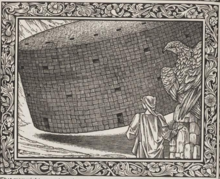
Back La Famodomo Esperanto Le Palais de la Renommée French La casa della fama Italian 영예의 집 Korean The House of Fame Dutch Berømmelsens hus NB
| The House of Fame | |
|---|---|
| by Geoffrey Chaucer | |
 Woodcut by Edward Burne-Jones of the house "made of twigs" from "The House of Fame" | |
| Original title | Hous of Fame |
| Written | c. 1374–85 |
| Illustrator | Edward Burne-Jones (1894 edition) |
| Country | England |
| Language | Middle English |
| Subject(s) | Fame, Greek mythology |
| Genre(s) | Dream vision |
| Meter | Octosyllabic |
| Rhyme scheme | Couplets |
| Media type | manuscript |
| Lines | 2,005 |
| Preceded by | The Book of the Duchess |
| Full text | |
The House of Fame (Hous of Fame in the original spelling) is a Middle English poem by Geoffrey Chaucer, probably written between 1374 and 1385, making it one of his earlier works.[1] It was most likely written after The Book of the Duchess, but its chronological relation to Chaucer's other early poems is uncertain.[2]
The House of Fame is over 2,005 lines long in three books and takes the form of a dream vision composed in octosyllabic couplets. Upon falling asleep the poet finds himself in a glass temple adorned with images of the famous and their deeds. With an eagle as a guide, he meditates on the nature of fame and the trustworthiness of recorded renown. This allows Chaucer to contemplate the role of the poet in reporting the lives of the famous and how much truth there is in what can be told.
- ^ Chaucer, G. (1937). The complete works of Geoffrey Chaucer, pp. 326–348. London: Oxford University Press, Humphrey Milford.
- ^ Lynch, Geoffrey Chaucer ; edited by Kathryn L. (2007). Dream visions and other poems. New York: W. W. Norton. ISBN 9780393925883.
{{cite book}}:|first1=has generic name (help)CS1 maint: multiple names: authors list (link)